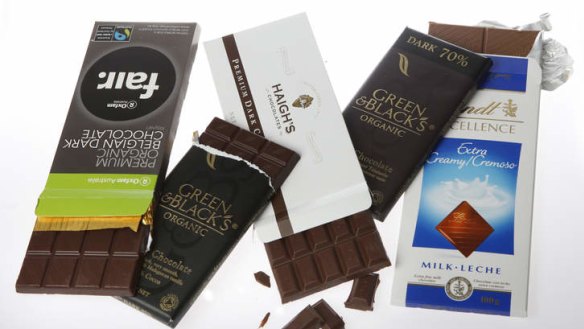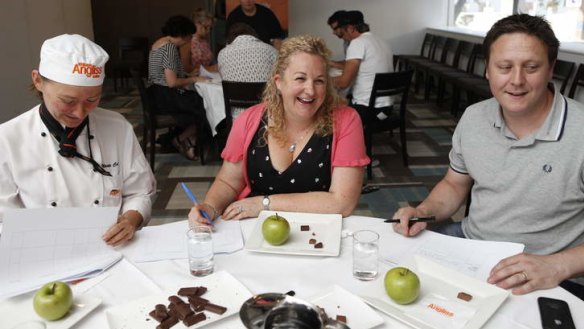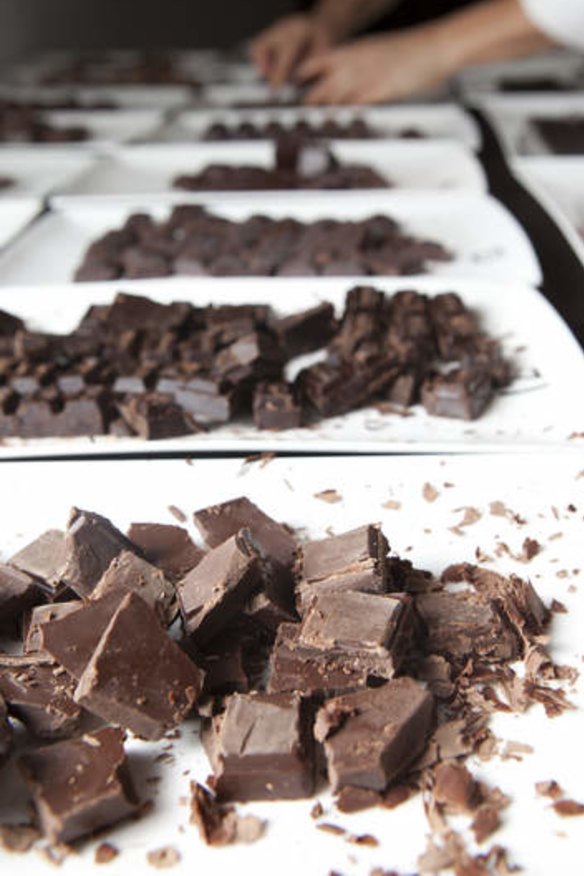Top chocs
Chocolate lovers and food professionals taste-test more than 20 popular chocolate bars. The results? Cocolossal!

The aroma of chocolate hung in the air. At two round tables sat some of the best palates in the food business - reliable tasters joined by chocolate makers, winemakers and a baker. In front of them were plates of chocolate, broken into pieces, the logos on top scratched away to obscure their identity. What set this taste test apart from others we have done, however, was the complete and utter silence.
In the quest to compare popular chocolate bars, our group of a dozen tasters became so immersed in decoding the complexity of the experience - the way the chocolate looked, smelt when rubbed with warm fingers, melted on the tongue and filled the head with aromas - they literally lost the power of speech. Of course, it's not that easy to talk with a tablet of chocolate slowly melting in one's mouth.
''The correct term is pip,'' William Angliss Institute patisserie instructor Nicole Caran says, describing the uniformly sized and shaped thin pieces of chocolate used in professional tasting. ''When judging chocolate, we look for a clear sheen and no sign of blooming - white layers that would indicate the chocolate has been affected by heat,'' she says. When broken, the chocolate should make a bright snapping sound, which indicates a high percentage of cocoa butter; when rubbed, it should release a pleasant aroma and feel smooth between the fingers. On the tongue, the chocolate should feel cool and melt fairly rapidly, which is also a good sign of cocoa butter. The texture should be very smooth, which is an indication that the cocoa nibs have been well conched - or ground - until very smooth and fine. ''Then you concentrate on aroma,'' Caran says.
The aroma of chocolate is experienced as the chocolate melts or as we break it apart with tongue or teeth. As this happens more chocolate is exposed and aroma compounds are atomised into gas that we detect in our nasal cavity. A good way of understanding the aroma of chocolate is to suck on a piece while pinching your nose and then suddenly releasing it. The flush of chocolate scented air into your nose from the back of your mouth can be quite overwhelming.
The tasting panel was loaded with wine-industry professionals because we wanted to get an understanding of chocolate through their palates. ''There are so many different characteristics,'' said Luke Campbell, director of cellar management company Vinified. ''We are experiencing wine-like aromas, the beauty of tropical fruit to, sadly, the horror of burnt rubber.''

The amazing array of aromas of chocolate can be attributed to the multi-layered fermentation of the cocoa pod and bean that turns starch into sugar, sugar into alcohol and lactic acid, alcohol in acetic acid and the creation of myriad amazing aroma compounds. The attention given to the drying of cocoa also affects flavour, (whether dried in the sun, over fire that lends a smoky flavour to the cocoa, or artificially dried by heated air). The time taken to grind, or ''conch'', the cocoa nibs helps determine the smoothness of the mouthfeel.
The milk chocolates were tasted first, followed by the chocolates with 51 per cent cocoa or more, which were labelled ''dark chocolate''. Generally, the tasters preferred the darker chocolates where the bitterness of the cocoa was balanced with more intense aromas. The tasters were able to compare smooth, well-conched chocolate with chocolates that, although quite aromatic, were slightly gritty and were marked down accordingly. The chocolates were bought in blocks through the usual retail outlets, but some popular brands were unavailable because the blocks had been displaced by the Easter stock of eggs. The chocolates were chosen because they were easily available in Victoria and NSW, and represented a cross-section. The tasting was not intended to be exhaustive; rather, it was to compare an array of block chocolate available.
What excited winemaker Neil Prentice about tasting so many different chocolates side by side were the memories that the different chocolates evoked. ''In one chocolate I got the aroma of cooking berry fruit and it reminded me of my family making jam when I was a kid.''

''Different manufacturers make their chocolate to evoke different responses,'' Savour Chocolate and Patisserie School's Kirsten Tibballs says. ''Some American chocolate makers aim to make the pip [chocolate] melt in the mouth more slowly to give the impression of value for money, while others produce more aromatic chocolate to evoke memory, particularly of childhood, which gives a nostalgic association to their product.''
With children and adults being given a lot of chocolate at Easter, Tibballs has some words of advice for chocolate lovers. She says that unless wrapped tightly soon after manufacture, Easter eggs and similar moulded chocolates are often not the manufacturers' best offering of quality. ''Because chocolate is so water- and odour-absorbing, and because eggs and the like have so much exposed surface area compared to their mass, they can absorb moisture from the air, which will change their texture and perhaps ambient odours.'' She says a small amount of good-quality chocolate is the perfect gift for the true chocolate lover.
The irony in what ostensibly appeared to be a dream job, tasting 20 different chocolates, was that the tasters felt overloaded by the experience. Social-media professional Melanie Young later tweeted: ''Sad news, Chocolate & I have broken up.''
How they ranked
1. Green and Black's Organic Dark, 85% cocoa
With aromas of sour cherry and smoke-infused tea, this smooth to slightly unctuous dark chocolate won the tasters over with its high cocoa content, little hit of Madagascan vanilla and sharp finish.
Poland, 100g, $3.98, 77/100
2. Oxfam Premium Organic Belgian Dark Chocolate, 72% cocoa
Although slow to melt, as it did it was smooth in the mouth and released strong roasted aromas plus fruit notes of sour berries, mandarin and sweet flora and again, a nice, sharp finish.
Belgium, 100g, $5.50, 72/100
3. Haigh's Premium Dark Chocolate, 51% cocoa
This really caught the attention of the tasters, with its elegant but ever so slightly gritty texture that was forgiven because of its morello cherry and candied peel aromas.
Australia, 100g, $9.25, 70/100
4. Lindt & Sprungli Extra Creamy Milk Chocolate, 30% cocoa
This is one very smooth chocolate. The only milk chocolate to make the top five, its wonderfully cool mouthfeel is backed by caramel, biscuit and date aromas and lovely floral notes.
France, 100g, $3.29, 66/100
5. Green and Black's Organic Dark, 70% cocoa
The balance of sweetness and acid finish, and tobacco aromas mixed with hints of orange and dark fruits pushed this chocolate to fifth place.
Poland, 100g, $3.98, 64/100
6. Kennedy & Wilson Dark Chocolate, 70% cocoa
This was described as a pleasant but not amazing chocolate, with herbaceous, nutty and coconut aromas.
Australia, 200g, $13.20, 63.5 /100
7. Blanxart Milk Chocolate, 48% cocoa
A soft gloss covers a smooth chocolate that balances sweetness and bitterness with lots of rich, dark cherry and plum notes. This Barcelona-made chocolate melted a little thick for some.
Spain, 125g, $9, 63/100
8. Bahen Co House Blend, 70% cocoa
The graininess of this West Australian chocolate detracted from the enjoyment of its pleasant smoky, dry hay and honey aromas.
Australia, 100g, $9.90, 61/100
9. Koko Black Chocolate, 34% cocoa
A pleasing chocolate with light caramel aromas and a slightly grainy texture.
Australia, 100g, $8.40, 59/100
10. Lindt & Sprungli Excellence Dark Chocolate, 85% cocoa
Many tasters did not like this chocolate, finding it bitter and unbalanced.
France, 100g, $3.29, 58/100
11. Kennedy & Wilson Milk Chocolate, 48% cocoa
The pip size was too big for the tasters. It didn't fit well on the tongue and therefore didn't melt well. Berry and citrus aromas and a long, balanced palate.
Australia, 200g, $13.20, 57/100
12. Oxfam Premium Organic Belgian Milk Chocolate, 36% cocoa
Soft to touch, slightly sticky on the palate and a little dull to taste.
Belgium, 100g, $5.50, 56.5/100
13. Coles Milk Chocolate, 26.5% cocoa
Smooth, sweet and milky.
Belgium, 100g, $3.26 55/100
14. Koko Black Chocolate, 80% cocoa
Smooth and creamy with aromas of tropical fruits. Some found it a little thin on the palate and a little chalky.
Australia, 100g, $8.40, 54/100
15. Blanxart Grand Cru Single Origin Congo, 82% cocoa
Fruity aromas could not appease the tasters' dislike of the lack of chocolate intensity and unbalanced, acidic finish.
Spain, 125g, $9, 50/100
16. Haigh's Premium Milk Chocolate, 32% cocoa
Too slow to melt, not smooth enough and not chocolatey enough, the tasters felt.
Australia, 100g, $9.25, 49/100
17. Whittaker's Dark Ghana, 72% cocoa
Fruity but too smoky, finishing with the flavour and aroma of bitter coffee.
New Zealand, 250g, $4.99, 48.5/100
18. Cadbury Dairy Milk, 26% cocoa
Sweet, grainy and fatty with some pleasant floral notes.
Australia, 200g, $4.99, 45/100
19. Old Gold Dark Chocolate, 45% cocoa
Grainy and acidic with aromas many found unpleasant.
Australia, 200g, $4.49, 34/100
20. Loving Earth Raw Chocolate, 60% cocoa
Made with raw cocoa beans, which do not grind to a smooth texture, this costly variety is not really a chocolate at all, but rather a sweet, raw cocoa confection with its own worthy charm.
Australia, 45g, $4.99, 26/100
Thanks to our tasters:
Darren Purchese, Burch and Purchese Sweet Studio; Kirsten Tibballs, Savour Chocolate and Patisserie School; Nicole Caran, William Angliss Institute; Phillippa Grogan, Phillippa's; Melanie Young, New Media; Howard Stamp, chef, The Wilde; Neil Prentice, vigneron, Prentice Wines; Hilary McNevin, food writer; Luke Campbell, Vinified; S.J. Farrell, co-creator, the Fringe Food Festival; Neil Hargreaves, food publisher, Group N.B.; Thanks to the William Angliss Institute.
Restaurant reviews, news and the hottest openings served to your inbox.
Sign up- More:
- Restaurant news
